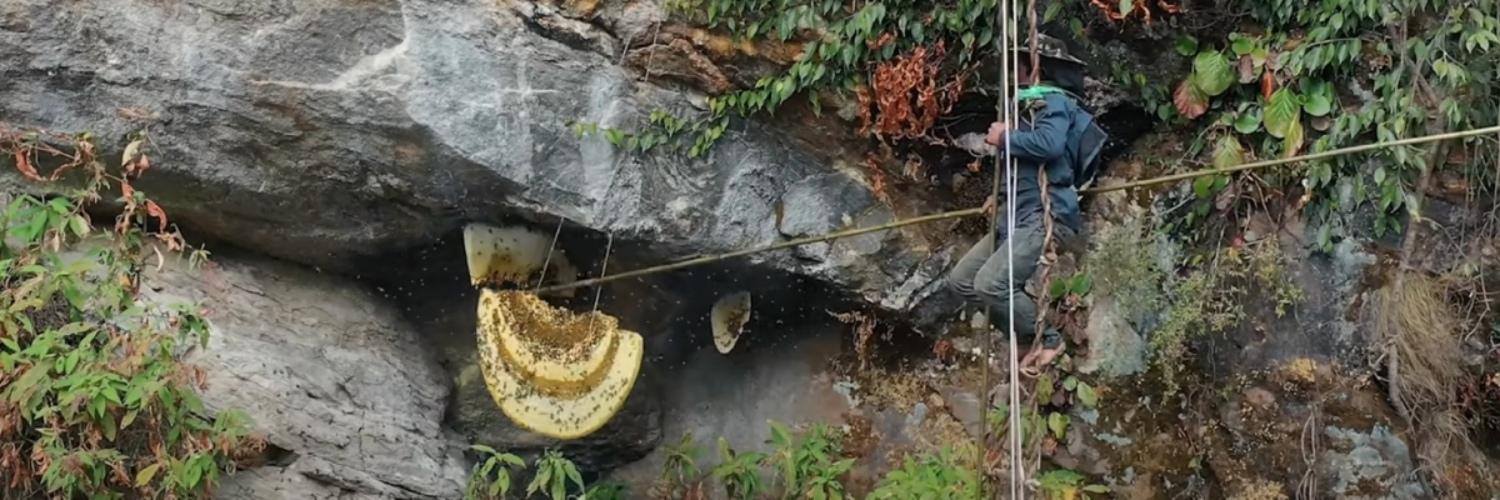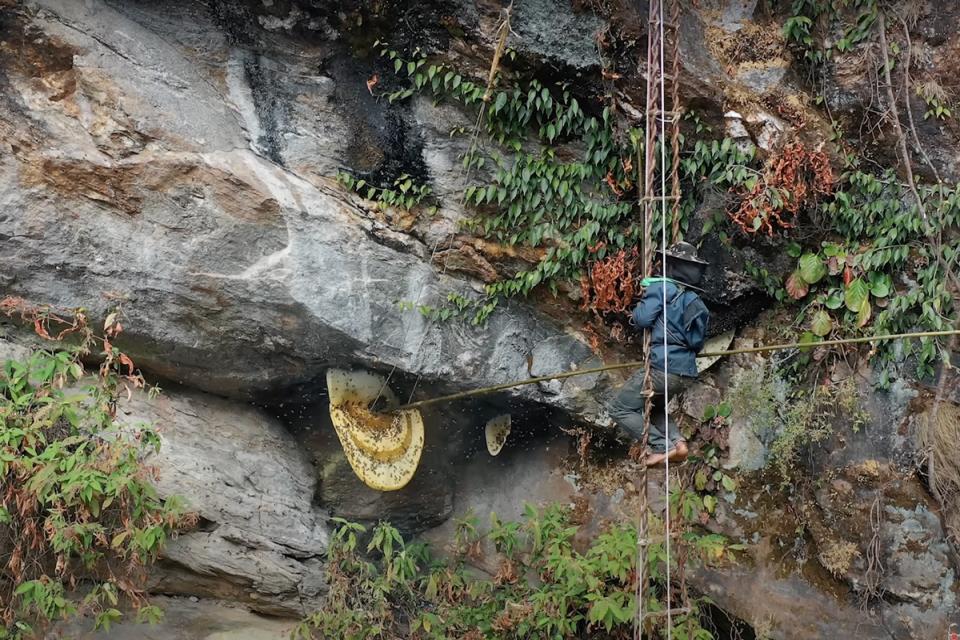Deep in the rugged hills and cliffs of Nepal, a centuries-old ritual continues to buzz with danger, mystique, and sweet rewards - Mad Honey Hunting. Practiced by indigenous Gurung communities, this ancient tradition of harvesting wild, hallucinogenic honey from towering cliffs is one of the last living links between human culture and untamed nature.
For trekkers, vloggers, photographers, and curious travelers, Mad Honey Hunting in Nepal offers more than just a visual spectacle - it’s a deeply immersive cultural experience that combines adventure, mythology, and eco-tourism.
In this blog, we’ll explore the famous locations for Mad Honey Hunting in Nepal, focusing especially on the Chamche, Ghalegaun, and Bhujung areas of Lamjung, while also introducing other lesser-known honey hunting sites. We’ll look into the history, cultural significance, best seasons to visit, how to reach these locations, and how you can witness the honey hunting experience firsthand through a guided tour.
What is Mad Honey Hunting?
Before diving into the locations, let’s understand what makes this honey so… mad.
Mad honey is harvested from the hives of the Himalayan giant honey bee (Apis laboriosa) - the world’s largest honeybee species, which builds massive hanging combs on sheer vertical cliffs, sometimes over 300 meters high. These bees collect nectar from Rhododendron flowers, which contain grayanotoxins, giving the honey its unique psychoactive (hallucinogenic) properties.
While a small dose can induce euphoria, warmth, and vivid dreams, higher doses can lead to nausea, hallucinations, or even serious health issues. Hence the term - mad honey.
This honey is highly valued in global markets, especially in Korea, China, and Japan, for its medicinal and aphrodisiac properties. But for the locals, it's more than a commodity - it’s a sacred connection to their ancestors and the land.
Why Mad Honey Hunting is a Spectacle
Imagine this: barefoot honey hunters descending towering cliffs with just bamboo ropes and hand-woven ladders, carrying smoking torches and baskets, while being swarmed by angry bees. This is not a sport for the faint-hearted.
These hunters perform rituals to seek the spirits’ blessings before the harvest. The honey is collected only a couple of times a year - during spring (April-May) and autumn (October-November) - to respect nature’s cycle.
It’s an extraordinary blend of:
-
Dangerous high-altitude climbing
-
Intimate spiritual traditions
-
Ecological balance and respect for bees
-
Raw Himalayan scenery
This is why Mad Honey Hunting in Nepal has gained attention from National Geographic, BBC, Vloggers, and Adventure Photographers worldwide.
Famous Locations for Mad Honey Hunting in Nepal
Let’s break down the best locations where you can witness or film this ancient ritual - starting with the heart of honey hunting: Lamjung District.
1. Chamche Area, Lamjung
Chamche, a picturesque hamlet located in the Annapurna Conservation Area of Lamjung, is among the top sites for Mad Honey Hunting expeditions.
Why Chamche?
-
Home to sheer cliffs where Himalayan bees make their combs.
-
Surrounded by lush forests and rhododendron bushes.
-
Easy to combine with the Annapurna Circuit Trek.
Cultural Highlights:
-
You’ll encounter Gurung villages where hunters will share stories passed down for generations.
-
Honey hunting here is treated with a spiritual reverence - you may witness pre-hunting rituals, animal sacrifices, or prayer offerings.
Vlogger/Photographer Tip:
-
Golden hour at the cliffs offers surreal lighting as hunters climb down against sunlit rock faces.
-
Drone shots are especially stunning here (seek local permission first).
2. Ghalegaun, Lamjung
Ghalegaun is often referred to as a model village for cultural tourism in Nepal. Perched at 2,100 meters above sea level, this Gurung village offers dramatic Himalayan views and is also a hotspot for Mad Honey Hunting.
Why Ghalegaun?
-
The cliffs around this area are known nesting spots for the giant honeybee.
-
The village is already popular among cultural trekkers - honey hunting is a hidden gem here.
Cultural Highlights:
-
Enjoy home-stays with warm Gurung families.
-
Participate in folk dance, local cuisine, and traditional Gurung rituals.
Vlogger/Photographer Tip:
-
Capture the contrast between modern curiosity and ancient traditions.
-
Use a wide lens to photograph the vast cliffs where bees build their nests.
3. Bhujung, Lamjung
Bhujung is one of the largest Gurung villages in the Lamjung region and lies close to Ghalegaun. This hidden gem is known for its vibrant honey-hunting traditions.
Why Bhujung?
-
Easily accessible via Ghalegaun Trek route.
-
Cliffside honeycombs are visible during the peak season.
Cultural Highlights:
-
Friendly villagers open their homes to visitors.
-
You can interact directly with local honey hunters, known for their storytelling and bravery.
Vlogger/Photographer Tip:
-
Document the entire journey - from prayers at dawn to comb harvesting.
-
Use natural soundscapes - buzzing bees, chanting, and cliff winds - for immersive content.
4. Other Mad Honey Hunting Locations in Nepal
While Lamjung is the epicenter, Mad Honey Hunting is also practiced in several other hilly and mountainous regions of Nepal, mostly in areas inhabited by Gurung, Magar, and Rai communities.
Besisahar Area (also in Lamjung)
-
Accessible and ideal for first-time viewers of honey hunting.
Dordi Rural Municipality
-
Known for massive honeybee colonies and less tourist footfall.
Naya Gaun (Gorkha)
-
Gorkha is home to rich Gurung heritage and also hosts honey hunting rituals on its high cliffs.
Tyangboche Area (Everest Region)
-
Rare sightings of Himalayan bees and their honeycombs - mostly studied by researchers.
Morang and Sankhuwasabha (Eastern Nepal)
-
Remote areas where honey hunting is still practiced but rarely open to tourists.
Best Season to Witness Mad Honey Hunting in Nepal
There are two main honey hunting seasons in Nepal:
|
Season |
Months |
Features |
|---|---|---|
|
Spring |
April to May |
Best for travel, blooming rhododendrons, long daylight |
|
Autumn |
October to November |
Crisp air, post-monsoon clarity, festivals |
Spring is generally preferred because:
-
Bees are most active.
-
Cliffs and forests are lush and buzzing with life.
-
Easier to trek and explore surrounding areas.
How to Reach Honey Hunting Locations
From Kathmandu:
-
Drive to Besisahar (6-8 hours) - Gateway to Lamjung.
-
Trek or drive to Ghalegaun, Bhujung, or Chamche - Depending on road access and season.
-
Join a guided Mad Honey Hunting Tour with Best Heritage Tour for safe access and local insights.
Tips for Trekkers, Vloggers, and Photographers
For Trekkers:
-
Moderate fitness is enough, but be prepared for steep sections.
-
Wear sun protection - the cliffs are exposed.
For Vloggers:
-
Use clip mics or directional mics to capture ambient sounds.
-
Document local stories, myths, and interviews.
For Photographers:
-
Carry zoom lenses for cliff shots.
-
A drone with good stabilization helps for high-angle views (with permission).
-
Sunrise and sunset are the best times for magical lighting.
Is Mad Honey Dangerous?
While watching it is perfectly safe, consuming mad honey should be done with care.
-
Safe doses are typically a spoon or less.
-
Avoid on an empty stomach.
-
Not recommended for those with heart or blood pressure issues.
When you travel with Best Heritage Tour, you’ll get the right guidance on how and how much to consume.
Ethical and Sustainable Travel Notes
-
Respect the honey hunters and their traditions.
-
Don’t interfere with the ritual.
-
Avoid asking for large samples or buying bulk honey unless offered by locals.
-
Leave no trace on the trails or cliffs.
Conclusion: Witness the Buzz with Best Heritage Tour
Mad Honey Hunting in Nepal is not just about bees and cliffs - it’s about ancient wisdom, bravery, and bonding with nature. It’s a unique cultural adventure that few travelers ever witness.
Whether you’re a trekker seeking thrills, a vlogger documenting Himalayan traditions, or a photographer chasing rare moments - this experience will stay with you forever.
Book Your Honey Hunting Experience Today!
Best Heritage Tour offers guided, ethical, and immersive Mad Honey Hunting Tours in Lamjung and other parts of Nepal.
Phone/WhatsApp/Viber: +977-9851149197
Email: info@bestheritagetour.com / bestheritagetour@gmail.com
Website: www.bestheritagetour.com
Office: Thamel Marg, Kathmandu, Nepal
Experience Nepal’s wildest ritual - raw, real, and unforgettable with Best Heritage Tour.
Author: Best Heraitage Tour
Date: 7th August, 2025


